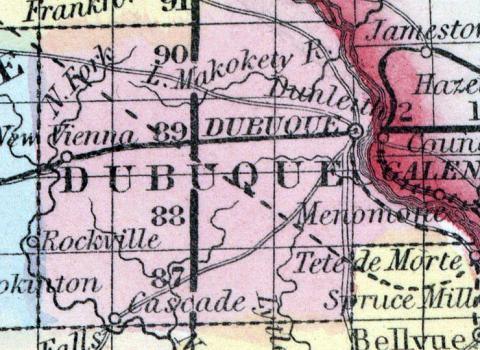DUBUQUE, a flourishing city of Iowa, and seat of justice of Dubuque county, is situated on the right bank of the Mississippi river, about 200 miles above Burlington, 450 miles above St. Louis, and 24 miles by water from Galena. The situation of Dubuque is regarded by some persons as more beautiful than that of any other city in Iowa. It stands on a broad plateau or terrace, which extends along the river for several miles. The city is regularly laid out and contains a number of handsome buildings. The following sketch of the place is extracted from the letter of an intelligent traveller:— "How sweetly this queen city, with its wide, rectangular, well-shaded streets, lies spread out upon its broad plateau, much as New Haven lies between the East and West rocks! But New Haven can never boast of such a verdure as here clothes alike bluff and plateau. And then the river, here a mile in width, rolling so majestically, flanked on the other shore with tall and verdant bluffs, and studded with islands of richest green." Dubuque is the central depot of the mining region of Iowa, and is a place of active trade. Large quantities of lead are taken from the mines in this vicinity, and sent down the river by steamboats: stone coal and limestone are also abundant. It is stated in the public journals that a quarry of variegated brown marble has been recently found on the bank of the river opposite Dubuque. The city contains a Catholic cathedral, a number of Protestant churches, a United States land-office, 4 newspaper offices, and 2 banks. In 1852 about 100 houses, chiefly of brick, were erected, and large sums were expended in improving the harbor and in paving the streets. The reported value of imports in 1852, was $1,670,390, and that of exports was $629,140, including 116,000 pigs of lead, valued at $348,000. The number of steamboat arrivals in 1851 was 351, and in 1862, 417. Dubuque is the terminus of the Northern Branch of the Illinois Central railroad, and of the Dubuque and Keokuk railroad, both of which are in process of construction. It is the oldest town in the state, having been settled by French Canadians about 1786. Population in 1853, about 7500. (Baldwin's New and Complete Gazetteer of the United States..., 1854)
The city of DUBUQUE, one of the largest and most densely populated in the State, is handsomely situated upon a natural terrace. The streets run parallel to each other, and owing to the peculiar soil at this location, are never muddy. This city is more compactly built, and contains a greater proportion of fine buildings than any other place in the State. Among these the Catholic Cathedral, court-house, and hotels stand prominent. The city is bounded on the west by a range of high cliffs, from which the prospect of the city and county is entrancingly beautiful.
Three daily newspapers are published in Dubuque : the "Express and Herald,'' the "Tribune," and the "Observer," each issuing, beside, a weekly edition. We have not the name of the weekly German paper.
The population of Dubuque County, according to the census of 1854, is 16,513; and of the city, according to "West's Statistics, 10,000. The number of buildings erected in the city last year was 332.
Of the society in Dubuque we need not remark farther than to state, that this population of 10,000 ably support eleven churches, one female seminary, one college, five select and common schools, twenty-four lawyers, and fourteen physicians. This city being the present terminus of two important railroads, must necessarily become a place of great commercial importance.
Good investments can be made in the establishing, at Dubuque, of manufactories of Red and White Lead, Lead Pipe, Shot, and Sheet Lead. Capitalists should investigate this matter. (Iowa As It Is in 1855; A Gazetteer for Citizens..., 1855)

